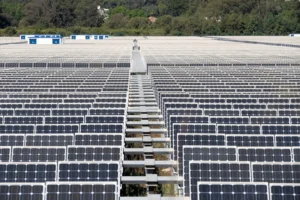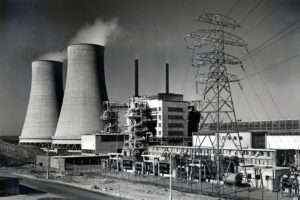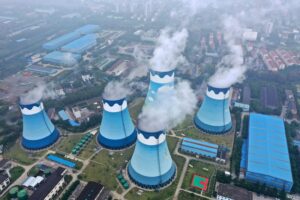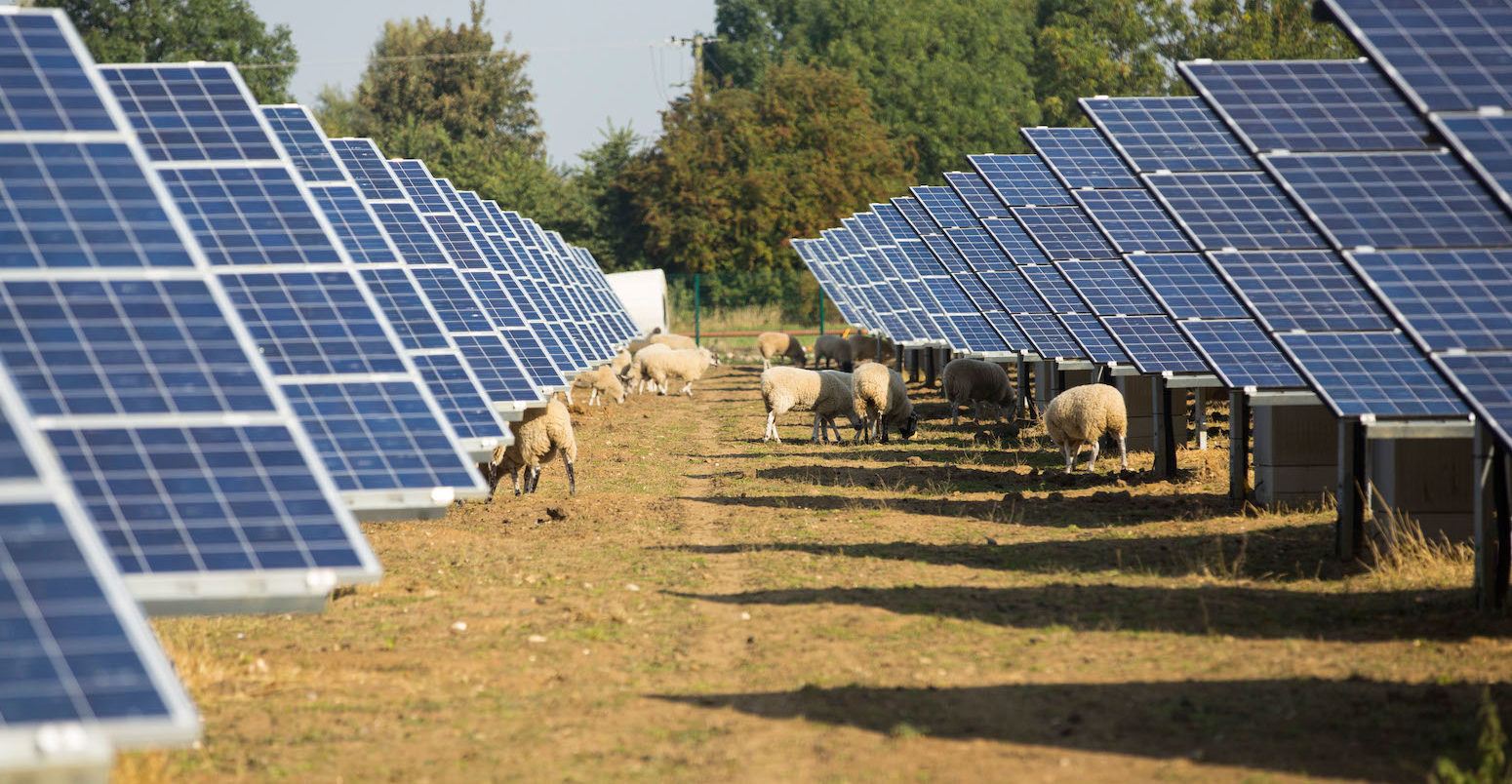
Factcheck: Is solar power a ‘threat’ to UK farmland?
Multiple Authors
08.25.22The “threat” posed to UK farms by the expansion of solar power has emerged as a campaign issue for the final two candidates in the race to become the nation’s new prime minister.
Both Liz Truss and Rishi Sunak have warned of solar panels “filling” the UK’s highest quality farmland, joining a chorus of their fellow Conservative MPs who have recently described solar projects as hazards for rural communities and food supply.
There has been some pushback to the view being promoted by Truss and Sunak. For example, in the Times, chief reporter Sean O’Neill wrote that the pair are “displaying staggering ignorance” and “pandering to the whingeing nimbys in their tiny electorate”. In the Daily Telegraph, the paper’s chief city commentator Ben Marlow wrote that “Britain’s culture wars have reached such epically absurd proportions that even the sun is now the enemy”.
Despite the claims, ground-mounted solar panels currently cover just 0.1% of all land in the UK.
Even government plans to significantly scale up solar in line with its net-zero target are expected to bring this up to just 0.3% of the UK land area. This is the equivalent to around 0.5% of the land currently used for farming – and roughly half of the space taken up by golf courses.
In this factcheck, Carbon Brief assesses some of the statements made by UK politicians about solar power in recent months, how land is used in the UK and the concept of “agrivoltaics” – systems in which farmland is effectively combined with solar power.
- Why are some UK politicians worried about solar power on farms?
- How much land in the UK is used for solar power?
- Are high quality farmlands under threat?
- How can land be used for both solar and agriculture?
- What are the impacts of solar panels on farming?
Why are some UK politicians worried about solar power on farms?
Liz Truss, who is currently the firm favourite in the Conservative leadership race, told a husting in Exeter at the start of August:
“Our fields should be filled [with] our fantastic produce…[They] shouldn’t be full of solar panels, and I will change the rules. I will change the rules to make sure…we’re using our high value agricultural land for farming.”
“I think one of the most depressing sights when you’re driving through England is seeing fields that should be full of crops or livestock, full of solar panels,” says Liz Truss. pic.twitter.com/yhOpD6y9Cw
— Adam Bienkov (@AdamBienkov) August 11, 2022
Two weeks later, Rishi Sunak wrote an article for the Daily Telegraph in which he seemed to be matching his opponent’s rhetoric, declaring:
“On my watch, we will not lose swathes of our best farmland to solar farms. Instead, we should be making sure that solar panels are installed on commercial buildings, on sheds and on properties.”
As Prime Minister, Rishi will fight for the interests of our farmers and protect our agricultural land
— Ready 4 Rishi (@Ready4Rishi) August 19, 2022
Read Rishi’s piece in the @Telegraph here👇https://t.co/DtuaynavpM#Ready4Rishi pic.twitter.com/g4qmsmyhwg
This idea, which was welcomed by climate-sceptic lobbyists, has not come out of nowhere. For months, backbench Conservative MPs have been speaking out against the number and size of new ground-mounted solar power projects being proposed, often citing local campaigns against projects in their constituencies.
Among them was Matt Hancock, the former health secretary and energy minister. In a Daily Mail article, he announced plans to stand in a supermarket car park with local campaigners to protest against a 2,500-acre solar farm in his constituency of West Suffolk.
Hancock used a common refrain, stating that “proposals for solar farms are often sited on high-grade agricultural land” and suggesting the focus should be on rooftop solar instead. He also warned of the potential for fires resulting from battery storage units and said a local golf course was at risk.
According to the UK parliamentary record Hansard, a lot of the conversation about this issue in parliament took place at two key debates. In March, MPs discussed the construction of “large solar farms” and Brendan Clarke-Smith, Conservative MP for Bassetlaw, stated that “the threat to agricultural land is the crux of the problem”.
James Gray, Conservative MP for North Wiltshire, who secured the debate in June on “solar farms and battery storage”, told parliament:
“Right now, we have a gigantic number of applications in my constituency for solar farms – I know of at least four…They are turning a rural area into an industrialised centre, which is really unacceptable.”
He later raised the issue of Russia’s invasion of Ukraine and resulting pressure on food supplies, telling parliament that, “at a time like this, using good productive land in the UK for solar farms is disgraceful”.
Gray’s comments are a continuation of historical Conservative anxieties around the construction of renewable energy in rural areas, which have previously led to a de-facto ban on the construction of new onshore wind – with considerable costs for the UK economy.
Despite the strength of feeling among some local campaign groups, the evidence suggests that most people in the UK, including 73% of Conservative party members, back these projects.
The government’s energy security strategy, published in April, contained various measures to deal with the UK’s energy crisis and achieve its net-zero targets, including a pledge to ramp up solar power capacity from 14 gigawatts (GW) to 70GW by 2035.
However, it also contained language that seemed to address Conservatives who were sceptical about ground-mounted solar, pledging to “consult on amending planning rules to strengthen policy in favour of development on non-protected land, while ensuring communities continue to have a say and environmental protections remain in place”.
Meanwhile, in Wales, the Labour climate minister Julie James issued a letter in March this year, saying that her department will prioritise the maintenance of high-quality farmland when considering solar projects. She wrote:
“Should solar PV array applications on BMV [best and most versatile] agricultural land come before the Department for Climate Change, the department will object to the loss of BMV agricultural land unless other significant material considerations outweigh the need to protect such land.”
How much land in the UK is used for solar power?
Solar farms in the UK currently have a combined capacity of around 14GW. According to analysis by the trade body Solar Energy UK, using Solar Media data, 9.6GW of this capacity comes from ground-mounted solar panels.
According to Solar Energy UK, for existing projects approximately six acres of land is required for every megawatt (MW) of power, which means that current ground-mounted solar covers an estimated 230 square kilometres (km2).
This makes up just under 0.1% of land in the UK.
In comparison, according to Corine Land Cover data, agricultural land covers 56% of the UK. Around 70,000km2 is pasture used for grazing cows and sheep, and around 67,000km2 is for growing cereals and legumes.
(It is worth noting that the more recent National Food Strategy, which uses the Corine Land Cover data alongside other sources, estimates that agricultural land covers 70% of the UK.)
As the chart below demonstrates, existing solar farms (dark yellow) currently use less land than golf courses (red) and airports (orange), which cover 1,256km2 and 493km2, respectively.
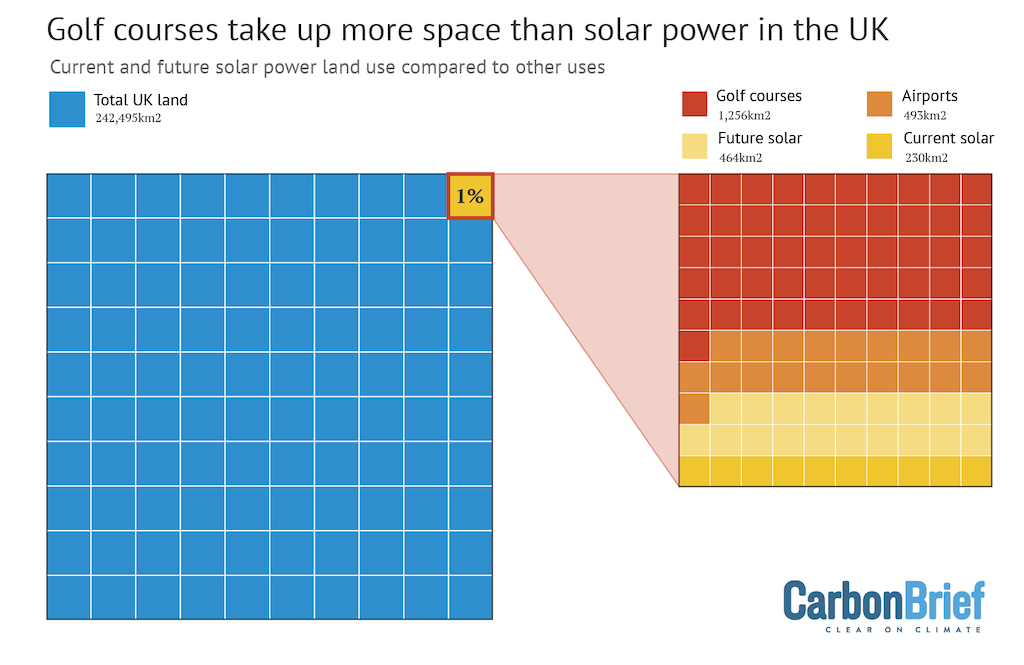
In April, the UK government released a new energy security strategy, which outlined plans to “look to increase” solar capacity “up to five times” by 2035. This would involve increasing ground-mounted solar capacity by an additional 38GW.
As solar technology becomes more efficient, it will require less space. ‘Bifacial’ panels, for example, capture sunlight on both sides of the panel.
The Department for Business, Energy and Industrial Strategy proposes that future solar power will need between two and four acres of land to produce 1MW of power. Assuming an average of three acres per 1MW, if the government meets its target of increasing solar capacity fivefold, ground-mounted solar could cover a total of almost 700km2 by 2035. This equates to nearly 0.3% of the UK’s land surface.
The yellow blocks in the chart below show the land cover of ground-mounted solar in 2022 (dark yellow) and the additional land cover of future solar under government plans to increase capacity five-fold (light yellow). The blue blocks show other types of land use in the UK.
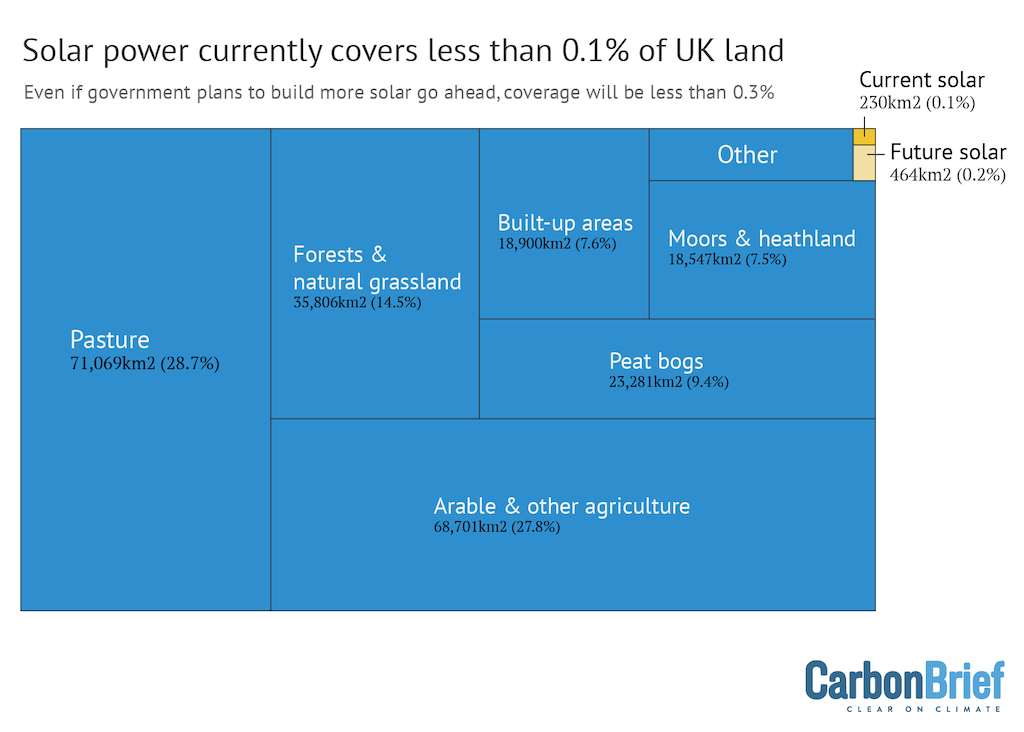
Ground-mounted solar power is built on several types of land. However, even if all future ground-mounted solar was built on farmland, the impact on UK food production as a result of the change in land use would be small.
This can be illustrated with an idealised example where all of the 700km2 to meet the UK’s ground-mounted solar target replaces land used to grow wheat. On average in the UK, one hectare of land produces around eight tonnes of wheat in a year. This means that 700km2 – or 70,000 hectares – could, theoretically, be used to grow 560,000 tonnes of wheat per year. Based on 2021 data, this would account for just 4% of the UK’s annual wheat yield – even in this extreme example.
Are high-quality farmlands under threat?
Despite the very small areas of land involved, Conservative politicians have warned that the nation’s “high-value” and “best” agricultural land is under threat from development.
Rather than criticising renewable power, they have expressed concerns about planning regulations. Sunak has said he will “review planning rules to ensure that high-quality farmland is sufficiently protected…that large-scale solar farms cannot be built on [the] best and most versatile agricultural land”.
(“Best and most versatile” is a term used to refer to Grade 1, 2 and identified Grade 3a agricultural land.)
MPs have repeatedly mentioned the National Planning Policy Framework, which James Gray MP said should “discourage the use of agricultural land for solar farms rather than encourage it”. An update to the policy was set for July, but has been delayed.
Also up for revision is the National Policy Statement for Renewable Energy Infrastructure (EN-3), which governs the construction of large-scale (more than 50MW in England) solar projects. This document already advises against the use of best and most versatile cropland for solar power “where possible”.
However, it adds that “land type should not be a predominating factor in determining the suitability of the site location”. Roz Bulleid, deputy policy director at thinktank Green Alliance, tells Carbon Brief this kind of language “might be what’s targeted” by politicians.
Despite the rhetoric coming out of Westminster, many farmers – who are unlikely to volunteer their best land for solar power – are positive about this technology. Not least because fields with solar panels can still be used to produce food. (See: How can land be used for both solar and agriculture?)
Carbon Brief spoke to Tom Martin, who has proposed a solar scheme on his mixed farm in Cambridgeshire. The project would see around 65,000 solar panels sited on approximately 100 acres across three fields.
Martin describes the idea of adding solar panels to grassland while still grazing sheep as “win-win”:
“It’s not ‘produce 10 units of energy’ or ‘produce 10 units of food’. It could be six units of both. And then, all of a sudden, your two halves are greater than the whole.”
The selection of which fields to use for solar is down to a mix of factors, explains Martin. This includes, for example, the best way to connect the system to the grid, but also choosing the fields that generally produce lower yields.
In addition, his farm is always seeing a “fluid” rotation between grassland and arable use, Martin says, noting that “in the last 10 years, we have changed 200 acres from grass into arable”. So even with moving 100 acres back to grass for the solar panels, the farm will still be producing more cereals than it did a decade ago.
A spokesperson from the National Farmers Union (NFU), which represents tens of thousands of farmers in England and Wales, tells Carbon Brief that their “preference” is that solar farms are built on lower quality agricultural land. But they add:
“Renewable energy production is a core part of the NFU’s net-zero plan and solar projects often offer a good diversification option for farmers.”
Kevin McCann, policy manager at trade body Solar Energy UK, tells Carbon Brief:
“Solar is also helping to keep UK farmers in business, by providing them with a stable revenue stream. More solar also means less dependence on gas, which is the reason why the UK is in a cost of living crisis.”
At the most recent renewable energy auction, the UK government’s main means of supporting renewable projects, solar projects secured power prices that were far lower than gas.
Pssst!
— Simon Evans (@DrSimEvans) February 16, 2022
Solar is now 88% cheaper than thought a decade ago, UK govt says – half its estimated cost of new gas power
Just running a gas plant in Feb 2022 is costing around FOUR times as much as we’d pay for new solar or wind
Thread with charts + FAQ
1/https://t.co/V2wefGvdy7 pic.twitter.com/XCprblByN8
Land used for solar power can still be used for farming both livestock and crops, often with little negative impact on yields. (See: What are the impacts of solar panels on farming?)
As planning permission for solar projects is not granted on a permanent basis, the land in question is technically only temporarily out of use and could even improve in quality while not being farmed. Also, solar projects will not necessarily be built on farmland.
The Department for Environment, Food and Rural Affairs (Defra) has made it clear that climate change, not solar power, is the “biggest medium- to long-term risk” to the nation’s domestic food supply.
Government research suggests that climate impacts under a medium-emissions scenario could cut the proportion of best and most versatile arable farmland from a baseline of 38% to 11% by 2050. Farmers are already facing crop failures this year due to extreme heat and drought over the summer.
Analysis by the charity CPRE found that 14,415 hectares (144km2) of best and most versatile land were developed for non-farming purposes between 2010 and 2022, representing an overall loss of just 0.6% of this land type.
Of this land, just 1,400 hectares (14km2) were used for renewable energy developments including solar power – 10% of the total. For comparison, 55% were used for housing.
Finally, analysis by the thinktank Green Alliance found that crops for biofuel production take up 77 times more land than that used for solar panels.
This is significant because, as Carbon Brief analysis shows, a hectare of solar panels delivers between 48 and 112 times more driving distance, when used to charge an electric vehicle, than that land could deliver if used to grow biofuels for cars.
PM Liz Truss complains of fields "full of solar panels"
— Simon Evans (@DrSimEvans) September 13, 2022
Yet a hectare of solar farm delivers 48-112x more driving distance, via an EV, than using the same land for biofuel
Turning UK land currently used for bioethanol over to solar could fuel a quarter of all UK cars
THREAD pic.twitter.com/yCByP1dMyJ
How can land be used for both solar and agriculture?
The debate around using farmland for solar often assumes that the two are incompatible. However, the concept of “agrivoltaics” – also known as agrisolar or agrophotovoltaics – outlines various ways in which land use can be optimised to address the dual needs of energy and food production.
The idea was first described in a 1982 paper, in which the authors “propose a configuration of a solar, e.g., photovoltaic, power plant, which allows for additional agricultural use of the land involved”.
In an agrivoltaic system, crops can be planted below and among raised photovoltaic panels. Dr M Ryyan Khan, an electrical engineer who studies renewable energy systems at East West University in Dhaka, Bangladesh, tells Carbon Brief:
“The idea is that if you put the solar panels on top of the crop fields, you might get benefits from both worlds.”
Because many crops do not need the full amount of light that the sun provides, Khan says, that “extra sunlight” can be harnessed for energy generation.
However, agrivoltaic installations are not just limited to growing crops, says Jordan Macknick, the lead energy-water-land analyst at the National Renewable Energy Laboratory in Golden, Colorado. He tells Carbon Brief:
“Agrivoltaics can mean 1,000 acres of pollinator habitat and native vegetation providing ecosystem services. It can also mean 500 acres of sheep-grazing underneath the panels. It can also mean five acres of someone growing tomatoes and peppers and watermelon underneath the panels.”
Japan is a world leader in agrivoltaics, with the first installations in that country coming online in 2004. According to a 2021 paper, Japan has nearly 2,000 agrivoltaic installations and more than 120 different crops are grown beneath the panels. The country also started the world’s first national funding programme to promote the technology, nearly a decade ago.
Today, examples of agrivoltaic installations can be found around the world, with pilot projects or working agrivoltaic farms on every inhabited continent. In the US, Macknick tells Carbon Brief, the vast majority of agrivoltaic installations are on land that is used either for native pollinator habitat or grazing land.
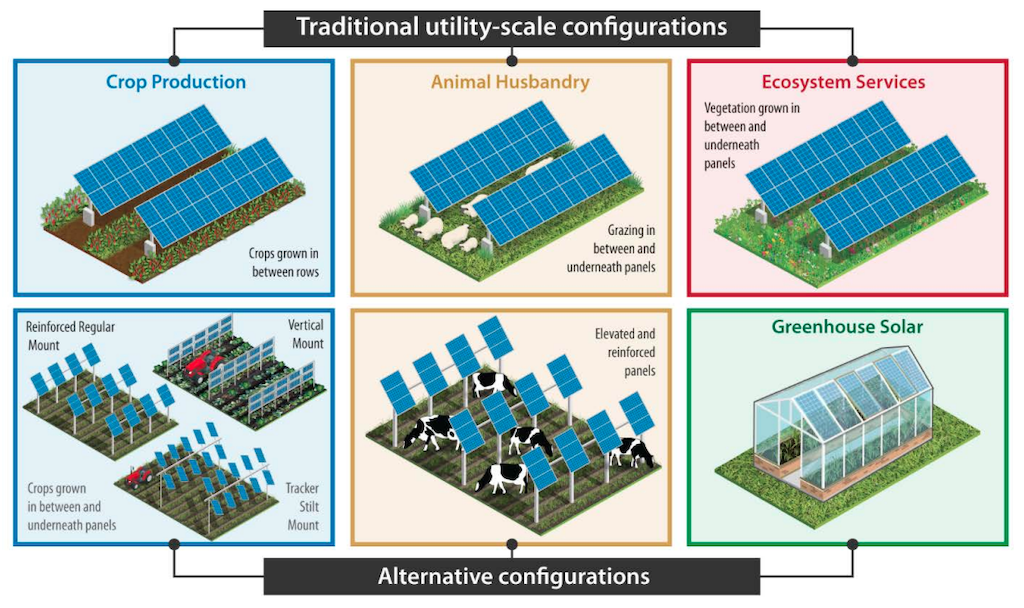
In 2021, the energy-generating capacity of all agrivoltaic systems worldwide exceeded 14 gigawatts, according to the Fraunhofer Institute for Solar Energy Systems, which notes that this capacity has “increased exponentially” since the early 2010s. The institute also projects that Germany alone has the potential to generate 1.7 terawatts of power from agrivoltaic systems.
The growing interest in agrivoltaics reflects a growing recognition of the vulnerability of agriculture to climate change, says Dr Seeta Sistla, an ecosystem ecologist at the California Polytechnic State University in San Luis Obispo. She tells Carbon Brief:
“What has become abundantly clear across the world is that climate change is absolutely here and it’s affecting every sector of our human lived experience, and it’s especially pertinent in terms of agriculture and land use and land sustainability.”
She continues:
“Given the sort of reality of climate change that is being felt in real time now versus even five or six years ago, I would say that people are much more willing to consider and think about putting in solar production, both as a climate mitigation strategy, but also as a farm mitigation strategy.”
Photovoltaic cells on a farm can provide an extra, stable source of income for farmers whose yields may become increasingly erratic due to climate change and increasingly frequent weather extremes, Sistla says. She tells Carbon Brief:
“Solar arrays can give footholds for small farms to remain in families, because it provides a constant stream of income versus crops which can fail or the prices can fluctuate.”
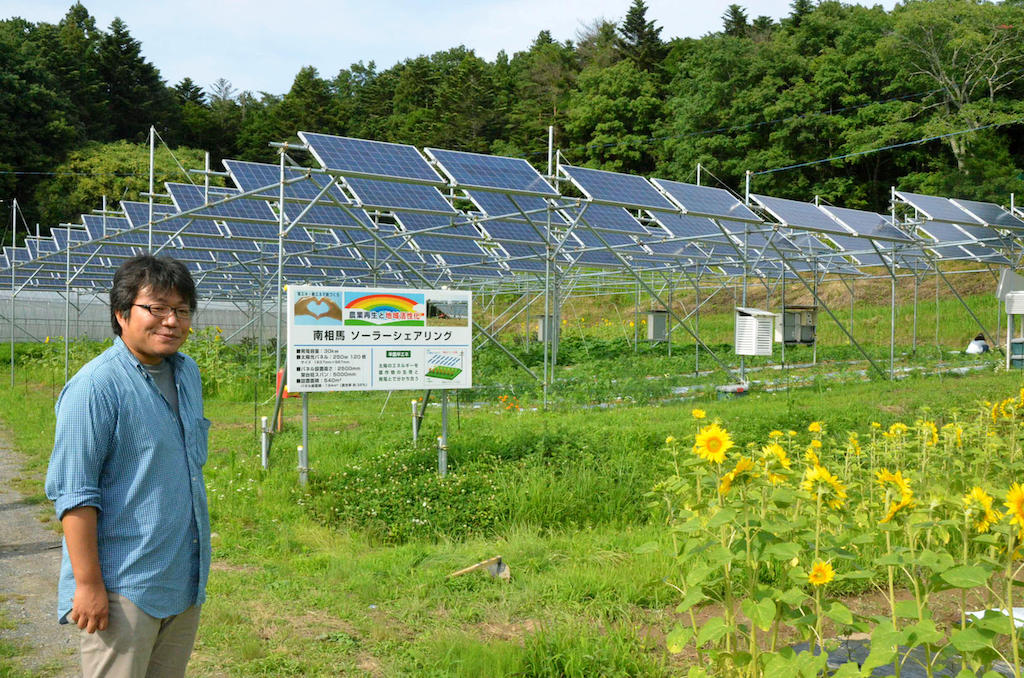
Martin, whose farm is mainly arable, but with some grassland for sheep and cattle, says the solar plans fit into the ethos of regenerative farming that incorporates livestock into an arable rotation. He explains:
“One of the reasons I’m excited about solar is that at the moment we bring in sheep during the winter and they graze on the stubbles [what remains of the crops once harvested] and our winter cover crops.”
The sheep are “tremendous at turning nutrients that we’ve managed to hold in vegetation form over the winter into manure, which is great for our spring crops to access”, says Martin.
However, in the springtime, the sheep go back to their home farm “because we have nowhere to put them”, says Martin:
“Whereas [with the solar park], actually they could stay on our farm and then move through to the wildflower grasses under the solar panels during the summer. That is a really kind of beautiful holistic system.”
And there are other options as well as grazing, says Martin. For example, the rows of solar panels in the proposed scheme will be placed four metres apart. This means that the gaps between them could be cultivated because farm machinery – such as combine harvesters and sowing machines for planting seeds – can be as narrow as three or four metres wide, he says.
The farm also hosts a community garden that “could work very well between the panels”, he adds.
While these options are not as flexible as a bare field, says Martin, having solar panels “complements our broader farming system”.
In addition, planting a “really biodiverse mix of native flora” around the solar panels – which “you could mix with legumes and herbs and grasses” – could also help fix carbon into the soil, says Martin. This would mean restoring soil carbon, producing food and generating energy at the same time, he says:
“Then we’re getting into the territory of win-win-win and that gets even more exciting.”
What are the impacts of solar panels on farming?
The effects of agrivoltaic arrays on crops is an active area of research, with some crops lending themselves to the system better than others.
For example, tall fruit and nut trees that grow above the elevated solar panels can block the panels and reduce their electricity generation. But other plants, such as leafy greens or berries, can benefit from the extra shade provided by the panels.
In general, Sistla tells Carbon Brief, agrivoltaics do well with low-growing crops that are typically harvested by hand and, therefore, do not require new, specialised equipment that can navigate the solar array.
A wide range of crops, including tomatoes, basil and pasture grass, have been experimentally shown to have comparable yields in agrivoltaic systems as in conventional farming. On grazing lands, solar arrays increase the forage quality, the water and nutrient content of plant matter and reduce water demand, Sistla says.
For example, a 2018 study in Oregon in the US found that grazing grasses grew better in the shade of solar panels, with “dramatic gains in productivity” providing 90% more biomass through the summer thanks to the areas under the panels being 328% more water efficient.
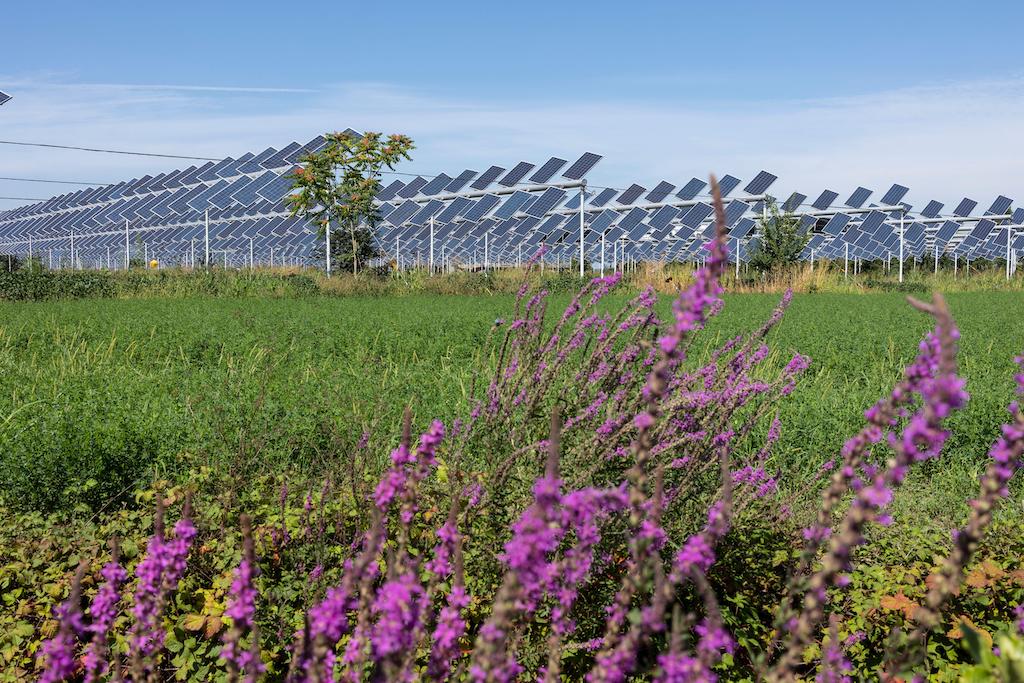
The panels can benefit livestock, too. Earlier this year, a four-year trial in Australia found that wool from merino sheep improved in both quality and quantity on farms that had installed solar panels. This was down to the “panels providing shelter for the sheep and grass”, the Independent reported.
Just as the choice of crop can affect the potential of an agrivoltaic system, so too can the climate and location.
In the western US, where there is an “abundance of sun” and a lack of water, agrivoltaic research has had “very promising” results, Macknick says.
In arid regions, the shade provided by photovoltaic panels can improve water retention and protect delicate plants. The added shade can also be beneficial to farm labourers and grazing livestock during the heat of the day, Sistla says.
By contrast, the research has shown “much more nuanced results” in the northeastern US, Macknick tells Carbon Brief. During a typical summer, agrivoltaics have resulted in depressed yields of some crops. But in unusually hot or dry summers, the results are similar to those seen in arid regions. So agrivoltaics may be able to help mitigate some of the climate extremes, he says.
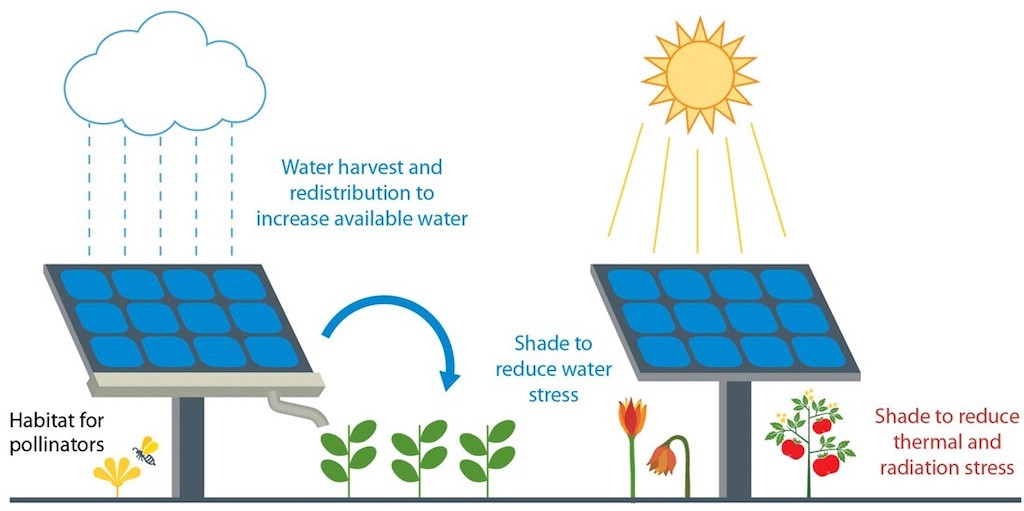
While much of the agrivoltaic research on crops has focused on vegetables, there is growing evidence that such setups can be profitable in “major crop” systems – those that grow staple crops such as rice, wheat and maize, which are typically less shade-tolerant – Khan says.
A 2019 study found that stilt-mounted photovoltaic panels could be installed on cornfields without reducing maize production. And a recent study that Khan worked on found that agrivoltaics deployed on rice paddies “will always be profitable” due to the relative prices of crops and electricity. With the right governmental policies and strategies in place, he says, smallholder farmers could lease their land to energy companies in return for a portion of the profits from the panels.
Just as photovoltaics can affect the crops below them, the crops can influence the efficiency of the panels above. One 2019 study found that photovoltaic energy production potential is actually greater over croplands than other types of land because of the cooling effect of the crops’ evapotranspiration.
What that study does not take into account, Khan tells Carbon Brief, is that the increased relative humidity can hasten the panels’ degradation. Instead of the 25-year lifespan of a conventional photovoltaic array, an agrivoltaic array may only last 20 years, he says – which should be taken into account when planning such an array and evaluating its economic potential.
The long duration of an agrivoltaic installation means that careful planning must be involved to ensure long-term success, Macknick says. A recent NREL report (pdf) laid out a number of considerations for successful agrivoltaic deployment. Among other recommendations, getting buy-in from farmers is paramount to success, Macknick says. He tells Carbon Brief:
“The partnerships that are developed right away between the solar developer and the agricultural entity are absolutely instrumental. They need to be working together from the beginning, in order to make sure you do have a successful arrangement where someone would want to farm for the next 20 years, because the solar projects will last 20, 25, 30 years. You’re gonna want someone to be farming all those years as well.”
Update: This article was updated on 26/08/2022 to include a mention of Ben Marlow's article in the Daily Telegraph.


